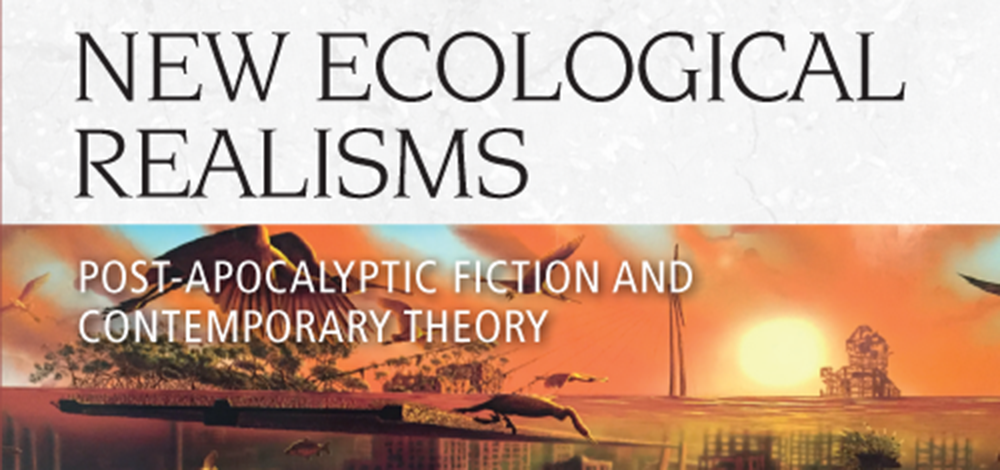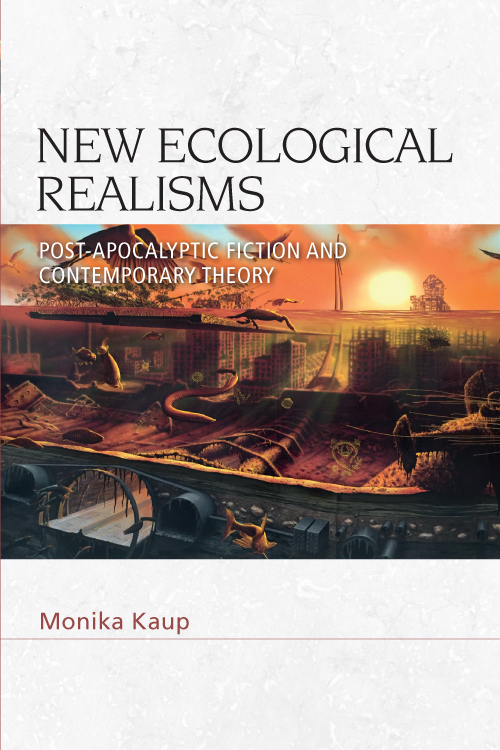
Graham Harman and Monika Kaup
Read the full conversation here.
Graham Harman: You begin your book New Ecological Realisms by discussing a widely observed turn in recent continental theory, from the preoccupations with language found in structuralism and poststructuralism to a renewed interest in the non-human world. Why do you think this turn happened, and what is it that triggered your own conversion?
Monika Kaup: As any cultural or historical phenomenon, the revival of interest in the real in general and in the other-than-human world in particular cannot be attributed to a single cause. It is rather the result of multiple interacting factors. That said, there is no doubt that one principal force is the growing popular awareness of climate change. As the harmful effects of climate change are becoming ever more apparent, the postmodern sensibility of debunking social and linguistic constructions has come to seem out of touch. As has been cleverly noted, “it’s not language that has a hole in its ozone layer.”
But postmodern constructivism has not just lost its sense of urgency. Outright alarm has resulted from the weaponization of postmodernism by the political extreme right (“climate change is a hoax invented by China”). The rise of post-fact and Alt-Truth regimes have demonstrated that critiquing normative concepts of facts, objectivity, and reality as manifestations of power/knowledge is not the province of left-liberal iconoclasts; it has become a dangerous tool of disinformation. (Most recent developments of Alt-Truth are threatening the very basis of democracy in the U.S. Habermas’s concerns about postmodernism as disguised neo-conservatism were thus proven right.) This point was also made by Bruno Latour in his influential 2004 essay, “Why Has Critique Run Out of Steam?,” which diagnosed the exhaustion of the Foucauldian politicized variety of constructivism.
“As the harmful effects of climate change are becoming ever more apparent, the postmodern sensibility of debunking social and linguistic constructions has come to seem out of touch.”
As I see it, the other major force prompting the revival of interest in reality beyond language and thought have been dramatic advances in the neurosciences since the 1990s. New brain imaging techniques have yielded unprecedented insights into neuronal activity correlated with specific states of mind. Although the goal of “naturalizing consciousness” remains out of reach—it remains unknown how and why neuronal events in the brain transform into non-material conscious experience—advances in the study of the neurobiology of the brain, similar to climate change, have contributed to the revival of realism and materialism. It is no accident that several intellectuals associated with speculative realism and new materialisms are also drawing on neuroscience (for example, Catherine Malabou and William Connolly). My book engages with two Chilean neurophenomenologists, Humberto Maturana and Francisco Varela, whose work straddles the mind/brain dichotomy. Neuroscientists as well as phenomenologists, Maturana and Varela have developed a new ontology of knowledge that draws on both brain physiology as well as phenomenology, the branch of modern continental philosophy dedicated to the study of consciousness. Maturana and Varela propose a revolutionary ontological theory of mind: knowledge is embodied action. Every act of knowing brings forth—or enacts—a world.
Finally, my own arrival in the new realist fold is related to my position as literary scholar working in an English department. As is well-known, English departments (as well as Comparative Literature departments) have been a home for the study of continental philosophy since the 1960s, when the arrival of “theory” opened up methods of literary criticism to structuralism and post-structuralism, various kinds of Marxisms and psychoanalysis, feminist, postcolonial and queer theory, to name just a few of the most influential movements. For several decades, the goals of literary criticism and critical theory meshed very well, and successive waves of theoretical innovation led to deeper and richer understandings of canonical literary works, as well as to the creation of alternative literary canons. Yet this symbiosis has recently broken down due to the hardening of dogmatic varieties of the “hermeneutics of suspicion.” As has been stated by scholars like Rita Felski, the postmodern excesses of self-reflexivity have turned critique into ritualized invocations of the depredations of power/knowledge that substitute for fresh insight. From the purview of literary studies, then, the turn to ontological questions breaks the monopoly the hermeneutics of suspicion has achieved in literary and cultural studies, especially in English departments, and especially the U.S., it stands to reinvigorate the stimulating diversity of critical inquiry that drew so many literary scholars to the study of theory decades ago.
Graham Harman: Your book itself centers on points of intersection between four pairings of philosophers and literary figures. In the Introduction, pages 4-5, you note that your focus is on “a new realism of complex and embedded wholes, actor-networks and ecologies, rather than a realism of isolated parts and things.” In your eyes, what is the virtue of steering away from individual things and towards wholes or assemblies of things?
Monika Kaup: My premise is the fundamental heterogeneity of reality, which is due to vast scalar differences between the very small (such as the microcosm or, further down the scale of existence, the atomic and subatomic levels) and the very large (for example, our solar system and the universe beyond). The reality that humans inhabit is located somewhere mid-way between these two extremes, in the macrocosm of discernable things and organisms. Reality at different scales is radically different. Humans are natives of the macrocosm, where reality is organized around distinct individual things: chairs, dining tables, bodies, seeds, cars and rocks, or, to choose non-material examples, poems, mathematical numbers, or dreams. Things define the furniture of the universe that humans inhabit—indeed, the very term inscribes the object-centered outlook on reality. Humans are thus predisposed to conceptualizing reality as thing-oriented. But scientific developments in the 20th century showed that the mechanistic view of reality, which posits discrete things as ontological base units, fails to explain reality at other scales of complexity, such as in subatomic world, as well as in ecosystems at any scale, large and small. Quantum physics demolished the notion of solid individual objects, which do not exist at the subatomic scale, while the new science of ecology established that individual organisms and species cannot be understood in isolation, but must be grasped through their interaction with others in larger multi-species systems in which they are embedded. The ecological view of reality that inspires my study is thus inherently contextual and holistic.
Ecocritics like to point out that climate change poses the challenge of the “unthinkable”: humans have changed reality at scales of existence that lie outside the limited world of individual things that are phenomenologically accessible to humans through their senses. The problem is that the discrete things that seem self-evidently given to our understanding appear as such only because they are embedded in an unstated larger context—the macrocosmic world that is our native habitat. In Heidegger’s view, world is what is easily overlooked because it is too familiar. The defining feature of scalar differences in reality is emergence, a term that refers to the appearance of novel properties at higher levels of complexity. For example, the human body, just like a car or a block of wood, is composed of atoms and subatomic particles. But these macrocosmic unities are more than the sum of their atomic and subatomic constituent parts; they possess properties that do not exist at the lower levels, and that only emerge at higher scales (consciousness, for one). Other familiar examples of emergence are temperature and taste (which do not exist at the levels of individual component atoms), as well as, of course, life itself (the atoms an organism is composed of aren’t alive, but the organism is). Of course, sometimes it turns out that realities at different scales can be synthesized, as when Newton established that the laws of falling bodies in the human world (studied by Galileo) and the laws of planetary motion (studied by Kepler) are actually two different manifestations of the same underlying force (gravity). But the 20th-century scientific developments just mentioned have uncovered realities so alien to the macrocosmic thing-centered world available to humans that a different approach to the real is needed.
My argument for a new realism of complex and embedded wholes rather than of isolated things, then, responds to the scientific discovery of emergence and scalar embeddedness, the recognition that the world is not a collection of objects, but that it is organized through systems nesting within other systems at various scales. The contextual view of reality I defend posits that context is primary because what counts as real is field-dependent (in terms of Markus Gabriel’s fields of sense ontology). Are we speaking as subatomic physicists? As weekenders relaxing in our living rooms? Or as ecologists studying the food webs of endangered species? Once the domain or scale of existence has been established, there is a clear answer as to what counts as “real.” And because this answer varies (at our human scale things are primary, at other scales things dissolve into webs of relationships) context is the common denominator, even as the nature of that context varies. (In Gabriel’s argument, “the” world as a unified totality does not exist.)
Speculative realism seems to be drawn to objects in order to escape correlationism, which Meillassoux defines as the doctrine according to which “we never grasp an object ‘in itself,’ in isolation from its relation to the subject.” My own interest in new realism is less motivated by the specter of correlationism than by another specter, materialist reductivism. In more positive terms, I endorse the Latourian principle of irreduction that would establish the singularity of reality at all scales of existence, especially aesthetic artifacts such as literature.
Stay tuned
“A Conversation with Graham Harman and Monika Kaup on ‘New Ecological Realisms’” Part 2 – 4 coming soon!
Want to keep up to date on our latest Philosophy books? Sign up to our mailing list.
About the book
Presents post-apocalyptic fiction as a unique source of new realist ontologies
- Shows how new realism reshapes humanistic inquiry in the age of climate change
- Contributes to the rehabilitation and reframing of realism after postmodernism
- Introduces a new contextual and ecological realism that reconnects the human cultural world with non-humans and the environment
About the author
Monika Kaup is Professor of English at the University of Washington. She is the author of Neobaroque in the Americas: Alternative Modernities in Literature, Visual Art, and Film (University of Virginia Press 2012) and she is co-editor of Baroque New Worlds: Representation, Transculturation, Counterconquest (Duke University Press 2010).






